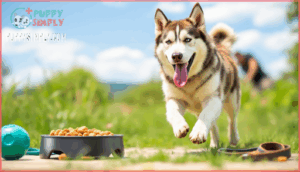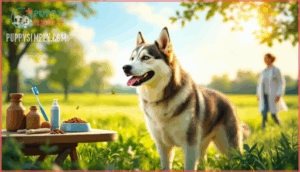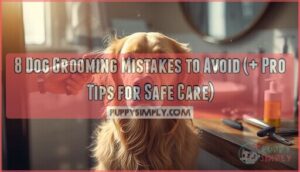This site is supported by our readers. We may earn a commission, at no cost to you, if you purchase through links.

The Husky Labrador mix inherits DNA from two wildly different working breeds: one bred to haul sleds across frozen tundra for days, the other to retrieve game from icy waters without complaint. This genetic collision creates dogs that look like they raided both parents’ closets—sometimes sporting a Lab’s otter tail with a Husky’s piercing blue eyes, other times wearing a wolf-gray coat over a retriever’s stocky frame.
If you’re considering one of these energetic hybrids, understanding what happens when ancient Siberian endurance meets Newfoundland’s eager-to-please temperament will help you decide whether you’re ready for a dog that might swim laps in your pool, then scale your fence to greet the neighbors.
Table Of Contents
- Key Takeaways
- Origins and History
- Appearance and Coat Colors
- Temperament and Personality Traits
- Exercise and Training Needs
- Health and Care
- Frequently Asked Questions (FAQs)
- What is a labsky & Labrador mix?
- What is a husky Labrador mix?
- Should you own a husky/Labrador mix?
- Are Siberian Husky & Labrador Retriever a good mix?
- Where did the Husky Lab mix come from?
- Who are the best Husky Lab mix owners?
- What is the average lifespan of a husky lab mix?
- How much does a husky lab puppy cost?
- Are husky lab mixes good with children and other pets?
- How often should you brush or bathe a husky crossed with a labrador?
- Conclusion
Key Takeaways
- The Husky Labrador Mix requires 60-90 minutes of daily vigorous exercise and consistent positive reinforcement training to prevent destructive behaviors like chewing, digging, and excessive vocalization that stem from their high energy levels and occasional stubborn streak.
- These hybrids carry genetic health risks including hip dysplasia (affecting up to 15% of Labs), elbow dysplasia (10-12%), and progressive retinal atrophy, making annual veterinary screenings and preventive care essential for their 10-14 year lifespan.
- Over 90% of Labskys form strong emotional bonds with families and respond well to food-based training, but more than 60% develop separation anxiety when left alone too long, requiring owners who can provide consistent companionship and structure.
- The breed’s unpredictable appearance ranges from Lab-like short coats to dense Husky double coats with striking variations in eye color (blue, brown, or heterochromia), requiring 3-5 weekly brushings that intensify to daily sessions during seasonal shedding periods.
Origins and History
The Husky Labrador Mix, also known as a Labsky or Huskador, emerged during the designer breed movement of the 1990s. Breeders intentionally crossed Siberian Huskies with Labrador Retrievers to create an energetic family companion. This hybrid combines ancient roots with modern development, blending the best traits of both parent breeds.
The Siberian Husky’s genetic lineage traces back roughly 4,000 years to the Chukchi people of northern Siberia, who bred these dogs for sled pulling and endurance work. Meanwhile, the Labrador Retriever originated in the early 1800s in Newfoundland, where fishermen relied on these dogs for retrieving fish and assisting with water-based tasks.
The Siberian Husky’s 4,000-year sled-pulling heritage meets the Labrador Retriever’s 1800s fishing roots in this purposeful crossbreed
Through careful breed selection and characteristics assessment, breeders recognized that crossing these two powerhouse breeds would yield a multipurpose hybrid. This mix balances the Husky’s stamina and independence with the Lab’s trainability and affectionate nature, making it perfectly suited for active families seeking a loyal adventure partner. To learn more about the needs of this breed, owners should research high energy needs to guarantee they can provide the necessary care.
Appearance and Coat Colors
While understanding the breed’s fascinating history helps you appreciate this hybrid, you’ll quickly notice that each Labsky’s physical appearance tells its own unique story. The Husky Labrador Mix appearance draws from two distinct genetic blueprints, creating stunning variations in coat colors and fur types. You’ll find coat patterns ranging from solid blacks and yellows to striking combinations with mask features inherited from the Husky lineage. Eye colors can vary dramatically—some dogs display the iconic blue Husky eyes, while others inherit brown Lab eyes, and a lucky few showcase heterochromia with two different colored eyes.
Common Husky Lab Mix characteristics include:
- Coat colors spanning black, white, gray, brown, yellow, and red combinations
- Fur types varying from short Lab-like coats to dense double-layered Husky coats
- Distinctive facial markings including masks, eyebrow spots, and unique patterns
- Medium to large build standing 20-28 inches tall at the shoulder
- Seasonal shedding patterns requiring weekly brushing during peak periods
Color genetics determine whether your dog leans toward one parent’s appearance or creates something entirely new.
Temperament and Personality Traits
Your dog’s Husky Labrador Mix temperament reflects a fascinating blend of loyalty and independence. In surveys, 100% of owners described their dogs as loving, with over 90% forming strong emotional bonds with their families. You’ll find these dogs are highly social—around 75% actively seek interaction with family members and new people.
Their intelligence shines through in training; nearly 85% respond well to positive reinforcement methods, and over 90% are motivated by food rewards. However, you should know that up to 30% display Husky-influenced stubbornness, requiring patient consistency.
Energy levels run high in over 80% of these dogs, and more than 60% develop separation anxiety when left alone too long. Understanding these Husky Lab mix temperament traits helps you provide the structure and affection they need to thrive. To manage their high energy, consider providing regular daily exercise needs to keep them happy and healthy.
Exercise and Training Needs
Given those personality quirks, your Labsky will need around 60 to 90 minutes of vigorous activity each day to channel all that boundless energy. Without adequate exercise routines, you’ll likely see destructive actions emerge—chewing furniture, digging, or excessive vocalization.
Your training needs should focus on positive reinforcement from day one. These intelligent dogs respond well to consistency and patience, especially when dealing with their occasional stubborn streak. Mental stimulation matters just as much as physical activity—think puzzle feeders and scent games.
Here’s what effective exercise and activity needs look like:
- Daily workouts including running, swimming, or hiking to burn off energy
- Dog training sessions using food rewards and praise
- Socialization techniques through regular dog park visits or playdates
- Interactive games like fetch or agility courses for training and action development
Start training tips early, ideally during puppyhood, to establish boundaries and reinforce good habits before independence kicks in.
Health and Care
Your Labsky’s vibrant energy demands attention to Husky Labrador Mix health and preventive veterinary care. Disease prevention starts with annual exams that screen for hip dysplasia—affecting up to 15% of Labradors—and elbow dysplasia, seen in roughly 10-12% of the parent breed. Progressive retinal atrophy and cataracts carry a combined 9% prevalence risk, making eye checks essential.
| Health Needs | Recommended Frequency |
|---|---|
| Hip/elbow screening | Annually |
| Dental cleanings | Once yearly |
| Weight monitoring | Monthly |
| Eye examinations | Every 6-12 months |
| Coat brushing | 3-5 times weekly |
Nutrition needs include high-protein diet plans (20-30% of calories) supporting muscle health, while Omega-3s promote coat vitality. Your Husky Labrador Mix grooming needs intensify during seasonal "blowouts"—expect daily brushing twice yearly.
Canine health thrives when you balance pet health and wellness through portion control, preventing obesity that accelerates arthritis. Health risks diminish markedly with consistent care, extending your companion’s 10-14 year lifespan.
Frequently Asked Questions (FAQs)
What is a labsky & Labrador mix?
Like combining two champion athletes into one unstoppable teammate, a Labsky blends Siberian Husky and Labrador Retriever genetics.
This Husky Lab Mix emerged in the 1990s, offering hybrid benefits like intelligence and affectionate energy that many owner experiences celebrate today.
What is a husky Labrador mix?
This hybrid breed combines parent breeds—the Siberian Husky and Labrador Retriever—creating a popular mix breed with hybrid benefits like intelligence and energy.
Breed popularity continues rising as owners discover unique mix characteristics in each Husky Lab Mix.
Should you own a husky/Labrador mix?
Choosing a Husky Labrador Mix isn’t for the faint of heart—it demands serious Time Commitment, Space Requirements, and Lifestyle Compatibility.
Family Suitability depends on your activity level and patience for training.
Cost Factors and Pet Ownership and Responsibility matter too.
Are Siberian Husky & Labrador Retriever a good mix?
Yes, these breeds complement each other well. The Siberian Husky brings intelligence and striking looks, while the Labrador Retriever contributes a gentle, family-friendly nature.
This Husky Labrador Mix benefits from Hybrid Vigor and Genetic Diversity, creating healthy, energetic companions perfect for active families.
Where did the Husky Lab mix come from?
Before social media influencers made designer dogs famous, the Husky Lab mix emerged in the 1990s through crossbreeding Siberian Huskies and Labrador Retrievers.
This hybrid origins story reflects a growing interest in combining parent breeds to achieve hybrid vigor and desirable breed characteristics from both genetic lineages.
Who are the best Husky Lab mix owners?
Active Families with time for daily exercise make ideal Husky Labrador Mix owners. Experienced Dog Owners who understand training challenges also thrive.
These Family Dogs need space, patience, and commitment to Pet Care, making Urban Dwellers without yards less suitable for successful Dog Ownership.
What is the average lifespan of a husky lab mix?
Your Husky Lab mix will usually live 10 to 15 years with proper care.
Lifespan factors like diet planning, health testing, and regular exercise directly impact the aging process and mortality rates, helping your dog thrive throughout life.
How much does a husky lab puppy cost?
A Husky Labrador mix puppy usually costs between $500 and $1,500 from reputable breeders. Adoption fees from shelters run lower, usually $50 to $
Factor in initial veterinary expenses and supplies when planning your ownership budget for this energetic cross.
Are husky lab mixes good with children and other pets?
Regarding family dynamics, these pups aren’t always a walk in the park. Your Husky Labrador Mix can be wonderful with children and other pets through early dog socialization and consistent socialization techniques.
Their affectionate nature fosters pet compatibility and household harmony, though supervision around small animals prevents prey drive issues. Proper family dogs require child safety measures and ongoing training for true compatibility with children and other pets.
How often should you brush or bathe a husky crossed with a labrador?
Brush your Husky Labrador Mix at least twice weekly to control shedding and prevent matting.
Bathe every six to eight weeks using a gentle dog shampoo, or more often if they get dirty.
Regular coat maintenance promotes skin health and keeps grooming manageable.
Conclusion
Think of husky labrador mixes as crossing a marathon runner with a golden-hearted helper—you’ll get a companion that needs both physical outlets and genuine partnership.
These hybrids thrive when their owners understand that exercise isn’t optional and training requires patience mixed with consistency.
If you’re ready to channel that double-breed energy into hikes, swims, and mental challenges, you’ll discover why this cross produces some of the most devoted, entertaining dogs you’ll ever meet.
Just remember: they’re not broken when they act like both breeds at once—that’s exactly what makes them extraordinary.









